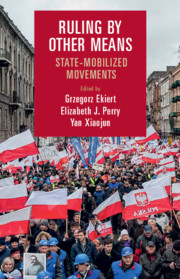Book contents
- Ruling by Other Means
- Cambridge Studies in Contentious Politics
- Ruling by Other Means
- Copyright page
- Contents
- Figures
- Tables
- Contributors
- Acknowledgments
- 1 State-Mobilized Movements: A Research Agenda
- 2 Manufactured Ambiguity
- 3 Suppressing Students in the People’s Republic of China
- 4 State-Mobilized Community Development
- 5 Enforcement Networks and Racial Contention in Civil Rights–Era Mississippi
- 6 Social Sources of Counterrevolution
- 7 Occupy Youth!
- 8 State-Mobilized Movements after Annexation of Crimea
- 9 Mirroring Opposition Threats
- 10 Mobilizing against Change
- 11 The Dynamics of State-Mobilized Movements
- 12 State-Mobilized Campaign and the Prodemocracy Movement in Hong Kong, 2013–2015
- 13 The Resurrection of Lei Feng
- Index
- Books in the Series (continued from p.iii)
- References
4 - State-Mobilized Community Development
The Case of Rural Taiwan
Published online by Cambridge University Press: 29 July 2020
- Ruling by Other Means
- Cambridge Studies in Contentious Politics
- Ruling by Other Means
- Copyright page
- Contents
- Figures
- Tables
- Contributors
- Acknowledgments
- 1 State-Mobilized Movements: A Research Agenda
- 2 Manufactured Ambiguity
- 3 Suppressing Students in the People’s Republic of China
- 4 State-Mobilized Community Development
- 5 Enforcement Networks and Racial Contention in Civil Rights–Era Mississippi
- 6 Social Sources of Counterrevolution
- 7 Occupy Youth!
- 8 State-Mobilized Movements after Annexation of Crimea
- 9 Mirroring Opposition Threats
- 10 Mobilizing against Change
- 11 The Dynamics of State-Mobilized Movements
- 12 State-Mobilized Campaign and the Prodemocracy Movement in Hong Kong, 2013–2015
- 13 The Resurrection of Lei Feng
- Index
- Books in the Series (continued from p.iii)
- References
Summary
In 1950s Taiwan, the defeated Kuomintang regime (KMT or Chinese Nationalist Party) sought to regain control of mainland China by transforming the island into a model province that would legitimize its right to rule. Knowing that the Chinese Communist Party (CCP) had established its rural base in large part through redistributive land reform, the KMT carried out a comprehensive land reform program of its own, which led to the creation of a smallholder farm economy with extremely low levels of inequality. In addition, the Nationalists built up an extensive network of farmers’ associations and implemented an agricultural policy that resulted in two decades of accelerated growth. According to former President Lee Teng-hui, agriculture played a textbook role in Taiwan’s development, meeting the domestic demand for food, accounting for a significant share of exports, and providing capital and labor for industrialization (Lee, 1971). As one of the first countries in the post–World War II period to achieve industrialized nation status, Taiwan stands out as an exemplary case of successful development.
- Type
- Chapter
- Information
- Ruling by Other MeansState-Mobilized Movements, pp. 86 - 109Publisher: Cambridge University PressPrint publication year: 2020
References
- 1
- Cited by



